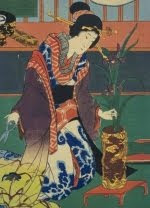 |
| Photo: texas.edu |
Dr. Nancy Stalker, professor of Japanese history and culture at the University of Texas at Austin, is visiting University of Oslo and gives a lecture on Ikebana in Japan's Postwar Recovery, May 6, 2013 04:15 PM - 06:00 PM, Helga Engs hus, Aud. 3.
"Few societies take as much pride as the Japanese in a reputation for a refined aesthetic in appreciating and cultivating nature. Ikebana, a discipline focused on the manipulation of flowers and plant material for decorative and artistic purpose, is a major aspect of this reputation.
With over ten million students at its peak in the 1960s, and more than three thousand officially registered schools, ikebana was (and remains) one of the nation’s largest cultural industries. Like nearly all of Japan's traditional arts, ikebana began as a wholly male pursuit, an arena to demonstrate wealth and cultural capital. Early twentieth century educational reforms, highly conscious of the Western gaze, made ikebana part of girls' school curriculum, resulting in a complete reversal of the gender ratio. While men continued to dominate the positions of ikebana headmasters and senior teachers, opportunities for women's labor and leisure increased steadily, spiking in the postwar period.
This presentation examines growth, competition, and transformation among the three leading schools of ikebana. It interrogates how these organizations shifted flexibly in response to emerging trends in art, market competition and women's changing lifestyles."












No comments:
Post a Comment